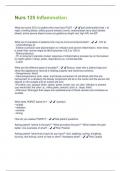Nurs 125 Inflammation
What are some S/S of a patient who may have PUD? - ✔️✔️pain before/after food + at
night, vomiting blood, coffee ground emesis (vomit), melena/black tarry stool (slower
bleed), active severe bleed comes out gelatinous bright red, high HR, low BP
What are 6 examples of patients who may be immunocompromised? - ✔️✔️- HIV pt.
- Chemotherapy pt.
- Elderly (confusion and disorientation w/ infection and severe inflammation. fever temp
is lower their normal might be 96.8 becomes 100.2 or 100.4)
- Malnourished pt.
- Pt. on long term steroids (mutes' response of inflammatory process; be on the lookout
for slight uptick in temp, pulse, respirations) ex. Corticosteroids
- Lupus
What are the different types of exudate? - ✔️✔️Serous: clear with a yellow tinge and
straw like appearance (wound is healing properly and receiving nutrients)
• Sanguineous: blood
• Sera-sanguineous: pink, clear, and bloody component of red blood cells that are
hemolyzed; on a dressing the bloody component will be in the center and the serous will
absorb on the outside and an outline will form
• Purulent: pus, opaque white, yellow, green, brown, tan, an odor; infection is present
(you would doc the color i.e., milky green, amount, size i.e., large, thick)
• Fibrinous: fibrinogen that seeps into epithelial level of blood vessels and combines w/
exudate
What does PQRST stand for? - ✔️✔️• position
• quality
• radiation
• severity
• timing
How do you assess PQRST? - ✔️✔️Ask patient questions
Asking patient "where is the pain?" "What provokes the pain?" "What makes the pain
better. Are examples of what? - ✔️✔️Pain Position
Asking patient "what kind of pain do you have? "dull, stabbing, aching, throbbing,
burning, and itching; come on fast or slow?" Assesses what? - ✔️✔️Pain Quality
, Asking patient "Does pain radiate to somewhere else (i.e., gallbladder, liver issues,
pancreatitis can radiate to back? Assesses what?" - ✔️✔️Pain Radiation
"Rate your pain from 0-10". Assesses what? - ✔️✔️Pain Severity
"when does it start and stop, i.e., ac, pc, bending over, what precipitates and brings it
on, sudden or gradually?" Assesses what? - ✔️✔️Pain timing
What can serious drainage indicate? - ✔️✔️Healing and wound may be receiving
nutrients properly.
pus, opaque white, yellow, green, brown, tan, an odor; infection is present (you would
doc the color i.e., milky green, amount, size i.e., large, thick) - ✔️✔️Purple that
drainage
fibrinogen that seeps into epithelial level of blood vessels and combines w/ exudate. -
✔️✔️Fibrinous
clear, and bloody component of red blood cells that are hemolyzed; on a dressing the
bloody component will be in the center and the serous will absorb on the outside and an
outline will form - ✔️✔️Sera-sanguineous
What are the signs & symptoms of Inflammation? - ✔️✔️• Heat
• Impaired function
• Pain
• Edema
• Redness (this and warmth occur due to an increase in blood and dilation of blood
vessels that increase vascular permeability)
• Exudate
Where will the blood be on a sera sanguineous wound dressing? - ✔️✔️on a dressing
the bloody component will be in the center and the serous will absorb on the outside
and an outline will form.
Can there be infection without inflammation? - ✔️✔️Yes, if patient is
immunocompromised.
Why would you ask "What comorbidities, other disease processes, and meds do you
take ?" - ✔️✔️
Conduct a focused assessment on affected body system, then physical assessment.
Why would you do this? - ✔️✔️If patient is showing s/s of something that needs to be
assessed first.




